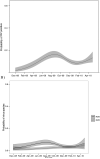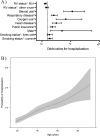Hospitalizations and outpatient visits for rhinovirus-associated acute respiratory illness in adults
- PMID: 26255695
- PMCID: PMC4744574
- DOI: 10.1016/j.jaci.2015.06.017
Hospitalizations and outpatient visits for rhinovirus-associated acute respiratory illness in adults
Abstract
Background: Rhinovirus is linked to asthma exacerbations and chronic obstructive pulmonary disease exacerbations in adults. The severity and rates of rhinovirus acute respiratory illnesses (ARIs) in adults are uncertain.
Objectives: We sought to determine rhinovirus-associated ARI rates in adults presenting for care in multiple settings and identify factors associated with rhinovirus detection.
Methods: This prospective, population-based cohort enrolled Tennessee residents 18 years or older in the emergency department (ED), outpatient clinics, or hospitalized for ARI from December 2008 to May 2010. Nasal/throat swabs were collected and tested for rhinovirus and other viruses by using RT-PCR. Rates of ED visits and hospitalizations were calculated and rhinovirus-positive and rhinovirus-negative patients were compared.
Results: Among 2351 enrollees, rhinovirus was detected in 247 (11%). There were 7 rhinovirus-associated ED visits and 3 hospitalizations per 1000 adults annually. Patients with rhinovirus, compared with virus-negative ARI, were more likely to present with wheezing (odds ratio [OR], 1.7; 95% CI, 1.23-2.35; P < .001), to be a current smoker (OR, 2.31; 95% CI, 1.68-3.19) or live with a smoker (OR, 1.72; 95% CI, 1.10-2.67), have a history of chronic respiratory disease (OR, 1.61; 95% CI, 1.17-2.22), and were less likely to be hospitalized versus seen in the outpatient setting (OR, 0.58; 95% CI, 0.41-0.83).
Conclusions: Rhinovirus is associated with a substantial number of ED visits and hospitalizations for ARIs in adults. There may be modifiable factors that can reduce the likelihood of presenting with rhinovirus-associated ARIs.
Keywords: Rhinovirus; acute respiratory illness; adults; emergency department; hospitalized; smoking.
Copyright © 2015 American Academy of Allergy, Asthma & Immunology. All rights reserved.
Figures




Similar articles
-
Human rhinovirus species associated with hospitalizations for acute respiratory illness in young US children.J Infect Dis. 2011 Dec 1;204(11):1702-10. doi: 10.1093/infdis/jir634. Epub 2011 Oct 19. J Infect Dis. 2011. PMID: 22013207
-
Rhinovirus-associated hospitalizations in young children.J Infect Dis. 2007 Mar 15;195(6):773-81. doi: 10.1086/511821. Epub 2007 Feb 2. J Infect Dis. 2007. PMID: 17299706 Free PMC article.
-
Rhinovirus frequently detected in elderly adults attending an emergency department.J Med Virol. 2011 Nov;83(11):2043-7. doi: 10.1002/jmv.22205. J Med Virol. 2011. PMID: 21915880 Free PMC article.
-
Rhinovirus infections in the upper airway.Proc Am Thorac Soc. 2011 Mar;8(1):79-89. doi: 10.1513/pats.201006-039RN. Proc Am Thorac Soc. 2011. PMID: 21364225 Review.
-
New developments in the epidemiology and clinical spectrum of rhinovirus infections.Curr Opin Pediatr. 2008 Feb;20(1):67-71. doi: 10.1097/MOP.0b013e3282f41cb6. Curr Opin Pediatr. 2008. PMID: 18197042 Review.
Cited by
-
[Rhinoviruses].Internist (Berl). 2019 Nov;60(11):1151-1154. doi: 10.1007/s00108-019-00672-4. Internist (Berl). 2019. PMID: 31463521 Review. German.
-
Clinical Significance of Rhinoviruses and Progress Toward Vaccination.Allergy Asthma Immunol Res. 2025 Jul;17(4):414-432. doi: 10.4168/aair.2025.17.4.414. Allergy Asthma Immunol Res. 2025. PMID: 40736772 Free PMC article. Review.
-
Clinical characteristics and outcomes of human rhinovirus positivity in hospitalized children.Ann Thorac Med. 2018 Oct-Dec;13(4):230-236. doi: 10.4103/atm.ATM_291_17. Ann Thorac Med. 2018. PMID: 30416595 Free PMC article.
-
Derivation and validation of a prediction rule for mortality of patients with respiratory virus-related pneumonia (RV-p score).Ther Adv Respir Dis. 2020 Jan-Dec;14:1753466620953780. doi: 10.1177/1753466620953780. Ther Adv Respir Dis. 2020. PMID: 32912054 Free PMC article.
-
Hidden in plain sight: the impact of human rhinovirus infection in adults.Respir Res. 2025 Mar 28;26(1):120. doi: 10.1186/s12931-025-03178-w. Respir Res. 2025. PMID: 40155903 Free PMC article. Review.
References
-
- Pelon W, Mogabgab WJ, Phillips IA, Pierce WE. A cytopathogenic agent isolated from naval recruits with mild respiratory illnesses. Proc Soc Exp Biol Med. 1957;94(2):262–7. - PubMed
-
- Bertino JS. Cost burden of viral respiratory infections: issues for formulary decision makers. Am J Med. 2002;112(Suppl 6A):42S–9S. - PubMed
-
- Hamparian VV, Colonno RJ, Cooney MK, Dick EC, Gwaltney JM, Jr., Hughes JH, et al. A collaborative report: rhinoviruses--extension of the numbering system from 89 to 100. Virology. 1987;159(1):191–2. - PubMed
-
- Kaplan NM, Dove W, Abd-Eldayem SA, Abu-Zeid AF, Shamoon HE, Hart CA. Molecular epidemiology and disease severity of respiratory syncytial virus in relation to other potential pathogens in children hospitalized with acute respiratory infection in Jordan. Journal of medical virology. 2008;80(1):168–74. - PMC - PubMed
-
- Kaplan NM, Dove W, Abu-Zeid AF, Shamoon HE, Abd-Eldayem SA, Hart CA. Evidence of human metapneumovirus infection in Jordanian children. Saudi medical journal. 2006;27(7):1081–3. - PubMed
Publication types
MeSH terms
Grants and funding
LinkOut - more resources
Full Text Sources
Other Literature Sources

